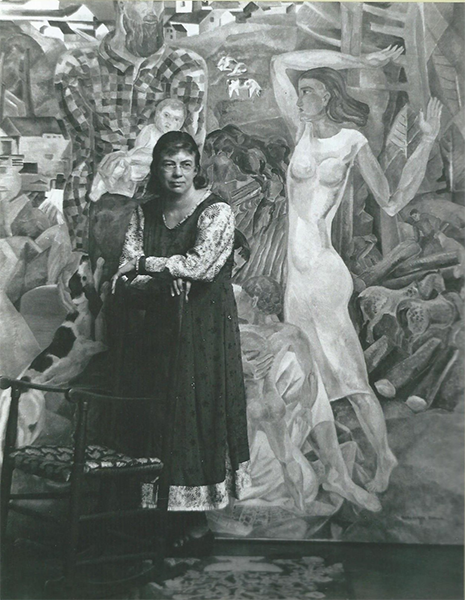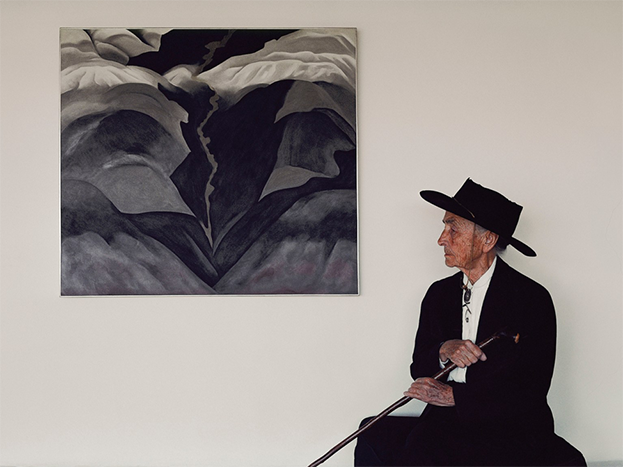In 1887 two girls were born who would grow up to be remarkable modernist artists. First to arrive, in Santa Rosa, California, was Marguerite Thompson. Two months later, Georgia O’Keeffe first saw the light of day in Sun Prairie, Wisconsin. Each would make a successful career in the artworld, achieving renown in a strongly male-dominated society. Their final reputations, however, would be completely uneven.

Born the daughter of a well-to-do lawyer, Marguerite grew up in Fresno. She had been accepted at Stamford University but abandoned those studies for an extended visit to an aunt in Paris, where she wrote articles on the Latin Quarter for her hometown paper and studied in progressive art schools. She met Gertrude Stein and Picasso and became close friends with Ossip Zadkine. Greatly influenced by the work of Matisse and the Fauves, she exhibited at the Salon d’Automne and the Salon des Independants. By the time of her return to California in 1911, she was undoubtedly one of the most avant-garde American artists of her time.
Against her parents’ wishes, she moved to New York a year later to marry William Zorach, whom she had met as a student in Paris. As Marguerite Zorach, she settled with her husband in Greenwich Village and exhibited in the famous Armory Show of 1913, through which mainstream America was introduced to modern art.
O’Keeffe grew up on a dairy farm in Wisconsin. After a year’s study at the Art Institute of Chicago, she moved to New York for two more years’ study at the Art Students League. For the four years following her studies, she worked as a commercial artist in Chicago. She left commercial art for further study in Virginia and New York and was working as an art teacher by the age of 25. In 1915 a friend showed some of O’Keeffe’s drawings to Alfred Stieglitz, a noted New York gallerist and photographer 23 years her senior, who fell in love with the drawings and, not incidentally, their maker. He would give O’Keeffe her first New York exhibition two years later, and they would eventually marry.
So we have two talented women here, each one intelligent, committed, and well-trained. Yet O’Keeffe has national recognition, even from persons who know little about art. Her paintings of flowers are highly sought-after: a four-foot-high painting of Jimson Weed brought $44,405,000 at auction four years ago. That was a record price for O’Keeffe, but her works often bring seven figures at auction. I have heard that the U.S. postage stamp issued years ago featuring one of her flower paintings sold more stamps than any other special issue except for that of Elvis.
Zorach, on the other hand, though she is known to curators and most collectors of modernism, usually rates a “Who?” from the general public. Her record price at auction, for a painting about the same size as the O’Keeffe painting mentioned above, was $264,000 in 2009. And her works consistently bring in the low-to-mid five figures at auction. What gives?
Part of the answer may be found in a recent exhibition Georgia O’Keeffe: Living Modern, which opened at the Brooklyn Museum last year and toured to several other museums. In addition to her paintings, the exhibition included clothing that O’Keeffe had made for herself (she was an accomplished seamstress), hats, and footwear. There were also plenty of photographs of the artist. In addition to being photographed by Stieglitz, one of the most noted photographers of his generation, O’Keeffe was to be photographed by a veritable Who’s Who of fine art and fashion photographers, beginning with Ansel Adams and Cecil Beaton and continuing through Irving Penn, Richard Avedon, and Annie Leibovitz. She was a natural model and had good bones. Her sense of fashion, both minimalist and elegant, remains stylish today. Even as an old woman dressed in black, she was slim and striking. The camera loved her.

Both women received a fair amount of art world press in the 1920’s, but by the 1930’s O’Keeffe had left Zorach far behind in terms of public recognition. Part of this may have been their dealers. Zorach was first handled by Newman Montross, who had opened his gallery in 1878 and was in his seventies when he showed Zorach in 1923. He was a well-respected dealer, but he had made his name with Barbizon-style and American Impressionist artists. O’Keeffe, on the other hand, had Stieglitz, an impresario of genius and a dealer whose name is forever associated with American modernism – besides O’Keeffe, Stieglitz’s 291 Gallery showed Marin, Hartley, Dove, and many other artists who have taken their places in art history.
Did O’Keeffe want children? Whether she did or not, Stieglitz didn’t – he had a daughter from his first marriage, and that was enough. O’Keeffe remained childless, able to concentrate single-mindedly on her art. Zorach had two children by the 1920’s, and it would have been unthinkable for a man of William Zorach’s generation to share child-rearing duties equally. Marguerite was drawn to making her wonderful large-scale embroideries in part because, once the initial design had been sketched onto the backing, the rote business of stitching could be done whenever she had 15 minutes or a half hour to herself. The works were modernist in design, but embroidery, which was traditionally considered “decorative” and “women’s craft,” further held her in the ghetto of women’s art.
Zorach complained early about the lack of interest in women’s art by dealers. “Dealers take men artists under their wing and promote them,” she wrote, “push them as a good business proposition, but they refuse to take women artists seriously.” She had to admit, though, that William could be useful in opening a door. “I started by holding joint exhibitions with my husband. We were a team, and as such, they were not afraid of me. I am certain that had I not had an artist husband and tried to exhibit on my own, I would have had all the difficulties.”
However much he admired O’Keeffe’s work for itself, Stieglitz had personal reasons for wanting her to be a success. Marguerite was too often an add-on to her husband’s career. The noted dealer Edith Halpert showed both Marguerite’s and William’s work in the late 1920’s, but she ceased exhibiting Marguerite after 1934 while continuing to show William’s work.
And so it continued. You can find (on Vimeo) an interview with William and Marguerite Zorach conducted by Edward R. Murrow on March 15, 1957, as a part of his then-famous Person to Person television series. Murrow addresses Marguerite as “Mrs. Zorach” while calling her husband “Bill.” Looking like a muffin-faced grandmother, she is allowed to show a few of her paintings before the camera follows William downstairs to his studio for the “real” interview.
The irony is summed up in one of the paintings Marguerite showed Murrow. It was an early oil by William with another by Marguerite on the reverse. (She explained that in their early days, lack of funds often caused them to use both sides of a canvas.) If the two paintings were on separate canvases and came up for auction today, I would bet that Marguerite’s painting would sell for a lot more that William’s. William is known much more today for his sculpture (which is somewhat out of fashion), and museums are making a conscious effort to remedy years of neglect of female artists.
But Marguerite’s prices aren’t anywhere near O’Keeffe’s. Critics’ opinions of their respective artistic achievements may vary, but no one can deny that, many years before the concept of “branding” oneself was part of the common parlance, O’Keeffe understood the strategy, and she used fashion and publicity to successfully shape public perception of her and her work. Indeed, she did it so successfully that she and her work became one.
“The intellect of man is forced to choose / Perfection of the life or of the work,” wrote Yeats. Leave it to a strong-willed woman to overthrow that dichotomy.

